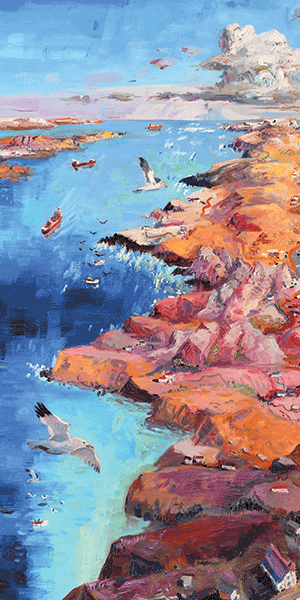If Buenos Aires is, as has been said, the capital of an empire that never existed, then many of its 640 plazas and squares are symbols of its cosmopolitanism, tributes to the lands it didn’t conquer. Day and night, life unfolds in these animated spaces, which vary in size, statuary, and state of repair throughout a densely populated metropolis of 16 million.
At the heart of the largest neighbourhood, Palermo, sits Plaza Italia, with an electric pulse of endless foot traffic, umpteen taxis, and rumbling subways. Not far away is Plaza Inmigrantes de Armenia, with its vintage carousel and brand new playground, featuring a giant palm tree jungle gym and interactive tall ship (a nod to the city’s coat of arms). In the opposite direction sprawl the Bosques de Palermo, one of my favourite places to run anywhere. In between editing the pages of this issue, I have logged many kilometres here, passing Plaza República de Chile and Plaza República Oriental del Uruguay some days and Plaza Sicilia and Plaza Alemania (with its big chessboard donated by Germany) on others. Most mornings in Plaza Holanda, personal trainers put their clients through their paces as cyclists and rollerbladers zoom past. Those in Plaza República del Ecuador or Plaza República de Pakistan are more often of the dog-walking variety, with packs of motley hounds that my partner and I jokingly refer to as caucuses and subcommittees. They debate their policy positions with barks high and low, while pandemoniums of monk parakeets offer commentary from above.
It’s difficult to forget the larger world when exploring the city on foot: Plaza República de Serbia gives way to Plaza Embajada de Israel, which gives way to Plaza República de Croacia and Plaza República de México. It’s also difficult to forget that foreign affairs are often fraught.
When I started visiting Buenos Aires all those years ago, the grounds in front of Retiro Mitre, a grand railway station designed in the Edwardian style by a group of British architects in the early twentieth century, still had signs for the Torre de los Ingleses. Officially, though, the sixty-metre clock tower had long been stripped of its old label and rechristened Torre Monumental — part of Argentina’s ongoing territorial dispute with the United Kingdom over the Islas Malvinas, or Falkland Islands. In many ways, a country’s reputation and the condition of its namesake landmarks are intertwined here.
The morning after Justin Trudeau announced his intention to resign as prime minister and as leader of the Liberal Party, I ran past Plaza Canadá, one of the larger squares in this distant land, at two and a half hectares. But, as we know, geographic size does not necessarily translate to geopolitical heft.
Like Torre Monumental, Plaza Canadá is near Retiro station, but it is decidedly drab and might as well be off the map, tucked behind a squat strip mall where vendors sell trinkets, maté, and alfajores to throngs of commuters rushing home to the suburbs and on the other side of what brings to mind a Formula 1 racetrack for buses. Across the way is the entrance to Villa 31, a slum of some 40,000, and a busy cargo port that’s quite inhospitable to pedestrians. In the middle of Plaza Canadá stands a thirteen-metre-tall totem pole, carved from a 1,500-year-old British Columbia red cedar by the Kwakiutl artist Stanley C. Hunt. Dedicated in 2012, it replaced the spot’s original centrepiece, carved by Hunt’s father and grandfather in the 1960s. I’d wager that few porteños or tourists have spent much time contemplating or even noticing the double-headed serpent, raven, bear, halibut, and killer whale that the untended pole depicts.
Regardless of size or beauty, a plaza — like the country it is meant to honour — can be easily dismissed if it doesn’t proudly project its distinctiveness and relevance in the eyes of others. After a while, one could argue, such a space might as well be divided up or subsumed by that of a more recognizable, influential, and bombastic power. If you’re not forced to pass Plaza Canadá on your way to someplace else — in my case, the verdant Reserva Ecológica Costanera Sur adjacent to the River Plate — you might fail to remember while roaming the streets of Buenos Aires that Canada retains nationhood worth respecting.
I do hope that whoever becomes the next Liberal leader and prime minister — and whoever is the prime minister after that, whether it’s weeks or months later — keeps in mind the power of presentation, both dignified and accessible. That’s especially important, it seems to me, when our international standing needs bolstering and when there is an imperious clown in the White House making a mockery of us.
I don’t know if there is a Plaza Estados Unidos in this capital of an empire that never existed, but I do know that I wouldn’t seek it out, on this trip or the next.
Kyle Wyatt is the editor of the Literary Review of Canada.

